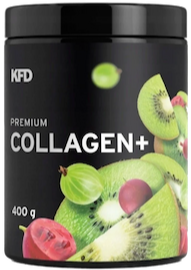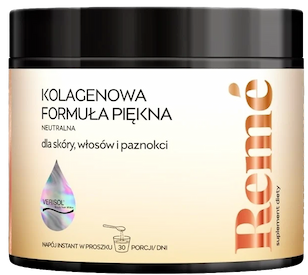Freeze-dried collagen (lyophilised collagen)
Does freeze-dried fish collagen perform better than hydrolysate?


Learn more about our editorial process
.

Learn more about our editorial process
.

Learn more about our editorial process
.

Learn more about our editorial process
.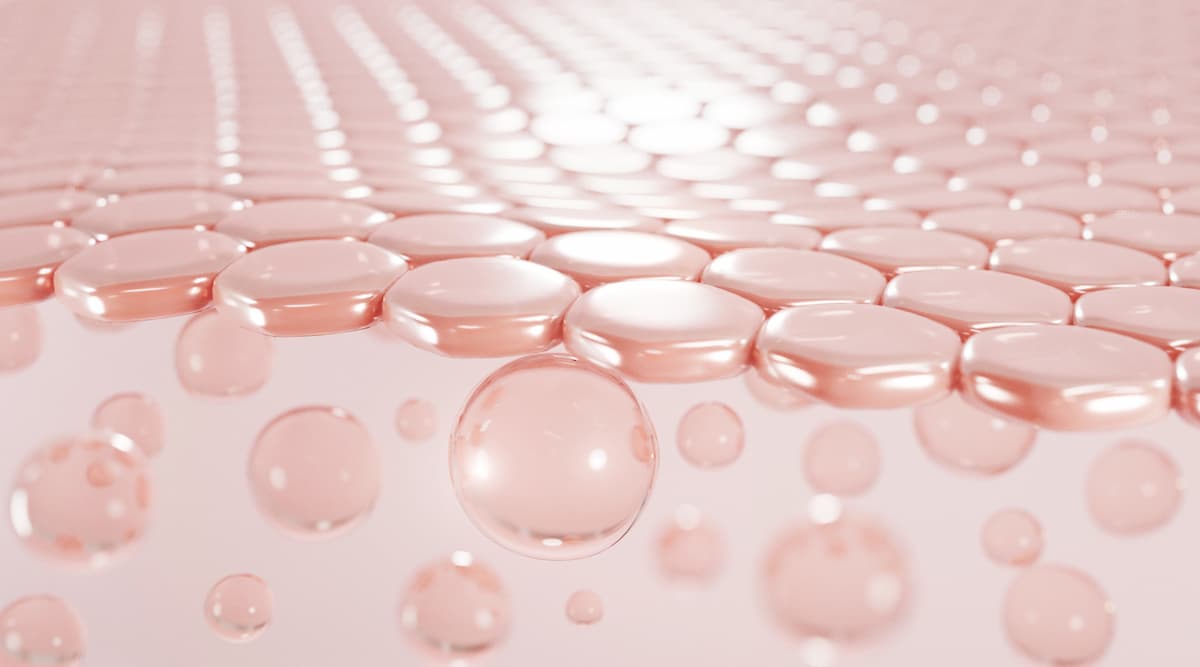
Why you can trust us
Articles on Natu.Care are written based on scientific research, data from government websites and other reliable sources. The texts are written in cooperation with doctors, nutritionists and other health and beauty experts. Articles are reviewed before publication and during significant updates.
.Learn more about our editorial process
.Information about advertisements
Content on Natu.Care may contain links to products from the sale of which we may receive a commission. When creating content, we adhere to high editorial standards and take care to be objective about the products discussed. The presence of affiliate links is not dictated by our partners, and we select the products we review ourselves completely independently.
.Learn more about our terms and Conditions
.Liophilised snacks are great for mountain trails, and chocolates with freeze-dried fruit are a hit with many confectioners. But is freeze-dried collagen ok?
.
I will tell you about it together with pharmacist and educator Ilona Krzak. We'll look at how it differs from other forms and whether it's worth reaching for in collagen supplementation.
We'll look at how it differs from other forms and whether it's worth reaching for in collagen supplementation.
From this article you will learn:
- What is freeze-dried collagen. .
- What to choose: freeze-dried fish collagen or hydrolysate.
- Why it is more common to use freeze-dried collagen.
- Why hydrolysed collagen is more commonly used. .
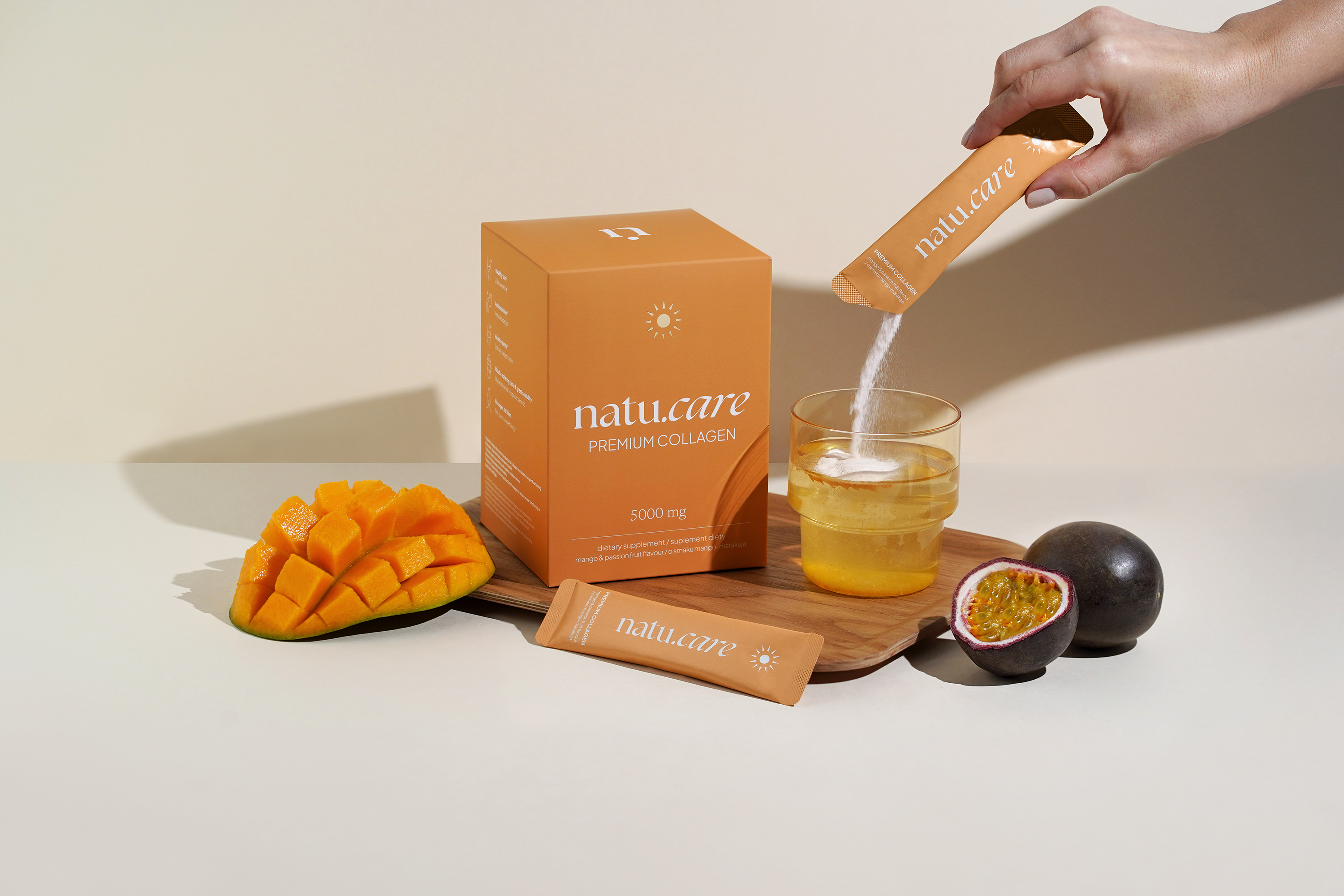
Sprawdź, za co pokochały go tysiące klientek Kolagen Premium (5000 mg) mango-marakuja -15% z kodem BLOG15
Natu.Care Kolagen Premium 5000 mg, mango-marakuja
Natu.Care Kolagen Premium dla zdrowia stawów, skóry, paznokci i włosów. Najlepsza przyswajalność. Optymalna dawka 5 000 lub 10 000 mg. Przebadany przez niezależne laboratorium.
Zobacz więcej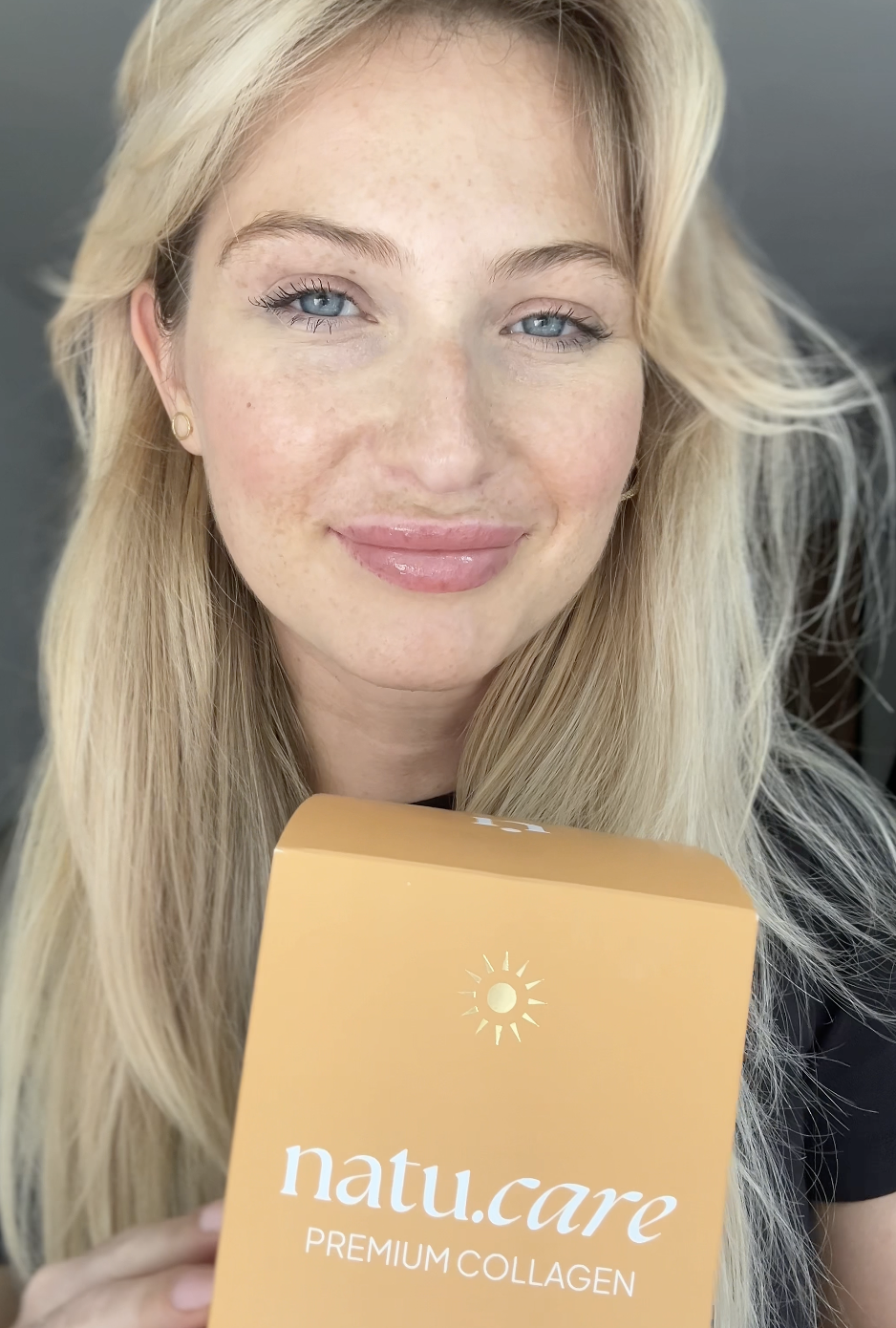
Wybrałam kolagen Natu.Care, ponieważ miał super opinie – a to było dla mnie bardzo ważne! Odkąd go stosuję, moja skóra znacznie się poprawiła i jest nawilżona, a na głowie pojawiły się nowe "baby hair".@Kasia S.
See also:
.
- Most Powerful Collagen - Ranking .
- Collagen for bones
- Collagen for joints
- Collagen for skin
- Collagen for wrinkles
- Facial collagen
- Collagen for cellulite
- Collagen for stretch marks
- Collagen for scars
- Fish collagen
- Collagen type 1
- Collagen type 2
What is freeze-dried collagen?
.
Lyophilised collagen is a form of collagen from which water has been completely removed, without disturbing its delicate structure - making it almost identical to that found in our bodies. Freeze-dried collagen is stable, dry and easy to store.
Liophilised collagen is often used as a base for dietary supplements, as it is very well absorbed by the body in this form - much better than natural collagen.
Because of the loss of water, freeze-dried collagen is more concentrated. There will be less pure collagen in 100g of natural collagen than in 80g of freeze-dried..
 .
.
Ilona Krzak Master of Pharmacy
.
Scientific research shows that collagen supplementation can improve skin elasticity, reduce wrinkles and promote connective tissue regeneration and is a sensible way to supplement collagen deficiency.
What is the freeze-drying process and how does it affect collagen?
.
Liophilisation, or sublimation, removes water from collagen. In the shortest terms, freeze drying is "drying by freezing" (freeze drying). You're familiar with those raspberry flecks in your favourite granola? They are freeze-dried.
The whole process consists of three main steps:
.
- .
- Freezing - when exposed to very low temperatures (around -50 °C), the water in the collagen freezes; .
- Primary drying - in a vacuum chamber and under low pressure, the frozen ice begins to sublimate, i.e. it turns immediately into water vapour (bypassing the liquid state); .
- Secondary drying - residual water is removed to produce a dry, fully stable powder; .
Collagen, like those granola raspberries, remains chemically intact and retains its natural properties.
The freeze-drying process yields so-called collagen sponges, which are used in medicine as dressing agents. They are excellent at absorbing exudates. They are biocompatible and hypoallergenic..
 .
.
Ilona Krzak Master of Pharmacy
These are a few products that contain freeze-dried fish collagen.
.
Natu.Care Collagen Premium 5000 mg, mango-maracuja
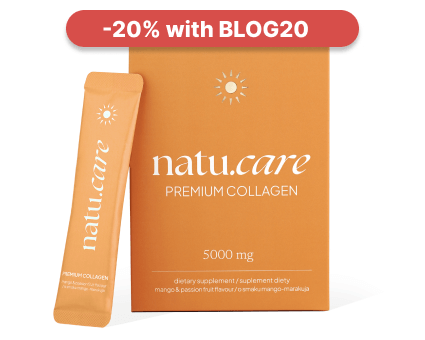
- Collagen content: 5000 mg marine collagen hydrolysate
- .
- Additional active ingredients: vitamin C, low molecular weight hyaluronic acid (and L-theanine and coenzyme Q10 in cocoa flavoured collagen or vitamin A and vitamin E in mango–passion fruit flavoured collagen)
- .
- Form: powder sachets
- .
- Dose: 1 sachet per day
- .
- Sufficient for: 30 days
- .
Product description
Fish collagen from the Natu.Care brand in a dose of 5000 mg. The formula contains a sufficient portion of the active substance to positively affect your joints, musculoskeletal system and immunity.
Take care of your tendons, joint cartilage, ligaments, muscles and even bones by supplying them with the building blocks to function properly. Move without bólu and provide the necessary support for any physical activity.
And as a „gratis” to regular supplementation, you will also receive firm skinóhand, healthy and shiny hair and strong nails.
Natu.Care Premium Collagen is available in two flavours – Cacao Bloom and Rise&Shine. Both formulas are based on the following active ingredients: marine collagen hydrolysate, wild roseóbud extract and hyaluronic acid.
Additionally, Cacao Bloom contains natural L-theanine, coenzyme Q10 and defatted Dutch cacao. Rise&Shine instead contains vitamin E and vitamin A.
These are the best collagens in the world.
These best fish collagens on the market also rós taste – Cacao Bloom is a treat for chocolate lovers. Rise&Shine will appeal to those whoóenjoy the refreshing taste of mangoófruit and passion fruit.
Pros and cons
Fish collagen from the Natu.Care brand in a dose of 5000 mg. The formula contains a sufficient portion of the active substance to positively affect your joints, musculoskeletal system and immunity.
Take care of your tendons, joint cartilage, ligaments, muscles and even bones by supplying them with the building blocks to function properly. Move without bólu and provide the necessary support for any physical activity.
And as a „gratis” to regular supplementation, you will also receive firm skinóhand, healthy and shiny hair and strong nails.
Natu.Care Premium Collagen is available in two flavours – Cacao Bloom and Rise&Shine. Both formulas are based on the following active ingredients: marine collagen hydrolysate, wild roseóbud extract and hyaluronic acid.
Additionally, Cacao Bloom contains natural L-theanine, coenzyme Q10 and defatted Dutch cacao. Rise&Shine instead contains vitamin E and vitamin A.
These are the best collagens in the world.
These best fish collagens on the market also rós taste – Cacao Bloom is a treat for chocolate lovers. Rise&Shine will appeal to those whoóenjoy the refreshing taste of mangoófruit and passion fruit.
Additional information
Fish collagen from the Natu.Care brand in a dose of 5000 mg. The formula contains a sufficient portion of the active substance to positively affect your joints, musculoskeletal system and immunity.
Take care of your tendons, joint cartilage, ligaments, muscles and even bones by supplying them with the building blocks to function properly. Move without bólu and provide the necessary support for any physical activity.
And as a „gratis” to regular supplementation, you will also receive firm skinóhand, healthy and shiny hair and strong nails.
Natu.Care Premium Collagen is available in two flavours – Cacao Bloom and Rise&Shine. Both formulas are based on the following active ingredients: marine collagen hydrolysate, wild roseóbud extract and hyaluronic acid.
Additionally, Cacao Bloom contains natural L-theanine, coenzyme Q10 and defatted Dutch cacao. Rise&Shine instead contains vitamin E and vitamin A.
These are the best collagens in the world.
These best fish collagens on the market also rós taste – Cacao Bloom is a treat for chocolate lovers. Rise&Shine will appeal to those whoóenjoy the refreshing taste of mangoófruit and passion fruit.
User review
Fish collagen from the Natu.Care brand in a dose of 5000 mg. The formula contains a sufficient portion of the active substance to positively affect your joints, musculoskeletal system and immunity.
Take care of your tendons, joint cartilage, ligaments, muscles and even bones by supplying them with the building blocks to function properly. Move without bólu and provide the necessary support for any physical activity.
And as a „gratis” to regular supplementation, you will also receive firm skinóhand, healthy and shiny hair and strong nails.
Natu.Care Premium Collagen is available in two flavours – Cacao Bloom and Rise&Shine. Both formulas are based on the following active ingredients: marine collagen hydrolysate, wild roseóbud extract and hyaluronic acid.
Additionally, Cacao Bloom contains natural L-theanine, coenzyme Q10 and defatted Dutch cacao. Rise&Shine instead contains vitamin E and vitamin A.
These are the best collagens in the world.
These best fish collagens on the market also rós taste – Cacao Bloom is a treat for chocolate lovers. Rise&Shine will appeal to those whoóenjoy the refreshing taste of mangoófruit and passion fruit.
Natu.Care Collagen Premium 10000 mg, cherry
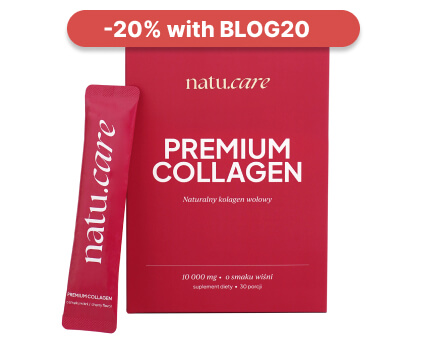
- Collagen content: 10,000 mg of hydrolyzed bovine collagen
- Additional active ingredients: vitamin C, low molecular weight hyaluronic acid, glucosamine, chondroitin, extract of Indian frankincense resin (boswellia serrata)
- Form: powder sachets for drinking
- Serving: 1 sachet per day
- Lasts for: 30 days
Product description
One of the strongest collagens on the market, providing as much as 10,000 mg per daily serving. This product can effectively support the condition of joints, skin, hair, and nails.
With this supplement, you will support your skeletal and joint system as well as your beauty, helping you visually halt the aging process and feel rejuvenated!
Pros and cons
Pros:
- The daily portion of collagen is very large – as much as 10,000 mg.
- Proven collagen formula – COLLinstant, whose effectiveness has been confirmed in clinical studies.
- Effective dose of hyaluronic acid, which additionally moisturizes the skin and positively affects joint health.
- Vitamin C supports the body's natural collagen production.
- Glucosamine is a fundamental building block of compounds found in joint cartilage and a component of collagen that gives elasticity to connective tissue in tendons.
- Chondroitin is a natural component found in the human body, mainly in cartilage. This large molecule (mucopolysaccharide) has the ability to absorb water, which helps maintain the elasticity and resilience of cartilage.
- Frankincense resin extract supports blood circulation and joint mobility and reduces their stiffness. It may help alleviate inflammatory conditions.
- The composition has been tested by the independent and accredited J.S. Hamilton laboratory.
Cons:
- None.
Additional information
Users praise Natu.Care Collagen Premium for the easy dissolving of the powder.
ALLDEYNN Collarose Fish
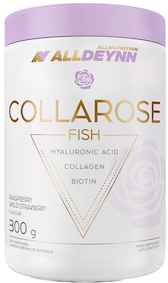
- Collagen content: 5000 mg hydrolysate fish collagen VERISOL F® .
- Additional active ingredients: vitamin C, hyaluronic acid, biotin
- Form: powder to dissolve in water .
- Dose: one scoop (6 g) of powder daily .
- Sufficient for: 50 days .
Product description
Atlantic cod collagen VERISOL F® contained in the formula are easily absorbed collagen peptides of fish origin. Regular supplementation can firm your skinóhand and slow down the ageing process. Your nails will become stronger and stop breaking. The addition of biotin will improve the condition of your hairów. The collagen portion is high enough to also have a good effect on your joints, muscles and bones.
Pros and cons
Atlantic cod collagen VERISOL F® contained in the formula are easily absorbed collagen peptides of fish origin. Regular supplementation can firm your skinóhand and slow down the ageing process. Your nails will become stronger and stop breaking. The addition of biotin will improve the condition of your hairów. The collagen portion is high enough to also have a good effect on your joints, muscles and bones.
Additional information
Atlantic cod collagen VERISOL F® contained in the formula are easily absorbed collagen peptides of fish origin. Regular supplementation can firm your skinóhand and slow down the ageing process. Your nails will become stronger and stop breaking. The addition of biotin will improve the condition of your hairów. The collagen portion is high enough to also have a good effect on your joints, muscles and bones.
Expert and user opinion
Atlantic cod collagen VERISOL F® contained in the formula are easily absorbed collagen peptides of fish origin. Regular supplementation can firm your skinóhand and slow down the ageing process. Your nails will become stronger and stop breaking. The addition of biotin will improve the condition of your hairów. The collagen portion is high enough to also have a good effect on your joints, muscles and bones.
DuoLife Collagen fish collagen 2500 mg
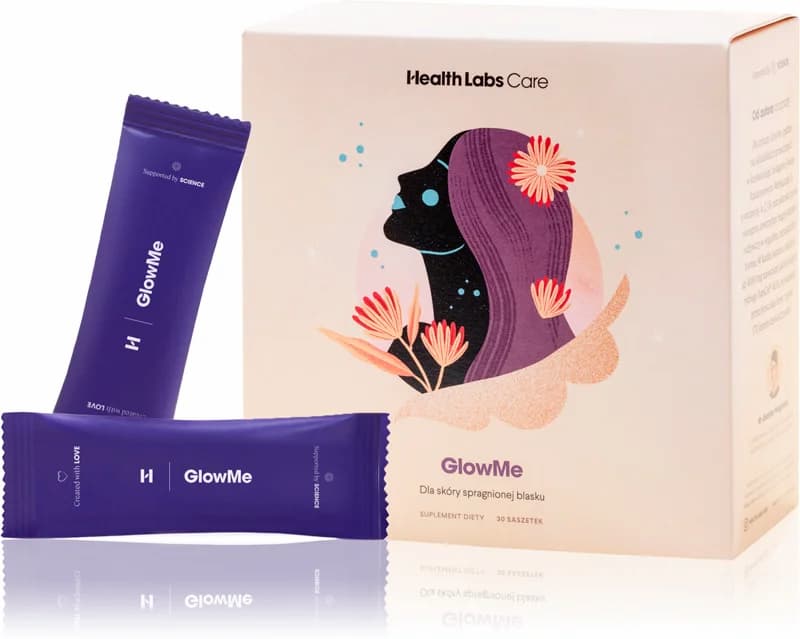
- Collagen content: 2500 mg collagen
- Additional active ingredients: vitamin C, silicon, glucosamine, hyaluronic acid, nettle and bamboo extracts
- Form: liquid to drink .
- Dose:25 ml .
- Sufficient for: 30 days .
Product description
100% natural collagen liquid without unnecessary ingredientsós. The composition of ingredientsós improves the appearance and condition of skinóry, hairów, nails. DuoLife is a good choiceór if you notice the first signs of skinóry ageing or want to stop this process. A tasty liquid, convenient to use.
Pros and cons
100% natural collagen liquid without unnecessary ingredientsós. The composition of ingredientsós improves the appearance and condition of skinóry, hairów, nails. DuoLife is a good choiceór if you notice the first signs of skinóry ageing or want to stop this process. A tasty liquid, convenient to use.
Additional information
100% natural collagen liquid without unnecessary ingredientsós. The composition of ingredientsós improves the appearance and condition of skinóry, hairów, nails. DuoLife is a good choiceór if you notice the first signs of skinóry ageing or want to stop this process. A tasty liquid, convenient to use.
User review
100% natural collagen liquid without unnecessary ingredientsós. The composition of ingredientsós improves the appearance and condition of skinóry, hairów, nails. DuoLife is a good choiceór if you notice the first signs of skinóry ageing or want to stop this process. A tasty liquid, convenient to use.
Pharmovit liquid collagen 10000 mg
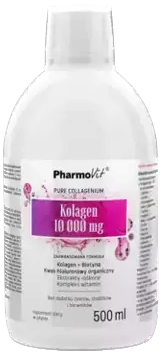
- Collagen content: 10000 mg hydrolysed bovine collagen types I and III .
- Additional active ingredients: hyaluronic acid, natural plant extracts, vitamin C, B vitamins, zinc, vitamin D
- Form: vials .
- Dose: 25 ml .
- Sufficient for: 20 days .
Product description
A solid daily dose of collagen for jointómuscle and bone health and beauty. The duo of collagen and vitamin C has a positive effect on each other, so that „the protein of youth” is better absorbed and more efficiently produced in the body.
Pros and cons
A solid daily dose of collagen for jointómuscle and bone health and beauty. The duo of collagen and vitamin C has a positive effect on each other, so that „the protein of youth” is better absorbed and more efficiently produced in the body.
Additional information
A solid daily dose of collagen for jointómuscle and bone health and beauty. The duo of collagen and vitamin C has a positive effect on each other, so that „the protein of youth” is better absorbed and more efficiently produced in the body.
KFD Premium Collagen+
Product description
High dose of collagen and a real bomb of vitamins C and D and organic sulphur. With this preparation the effects will come immediately. You will improve the firmness of your skin and reduce wrinkles. Your hair and nails will be strong and shiny.
A generous dose of collagen will improve the mobility of your jointsós, benefit your bone system and muscles. Do you do sports and need a product thatós able to keep up with your needs? This product will do the trick.
Pros and cons
High dose of collagen and a real bomb of vitamins C and D and organic sulphur. With this preparation the effects will come immediately. You will improve the firmness of your skin and reduce wrinkles. Your hair and nails will be strong and shiny.
A generous dose of collagen will improve the mobility of your jointsós, benefit your bone system and muscles. Do you do sports and need a product thatós able to keep up with your needs? This product will do the trick.
Additional information
High dose of collagen and a real bomb of vitamins C and D and organic sulphur. With this preparation the effects will come immediately. You will improve the firmness of your skin and reduce wrinkles. Your hair and nails will be strong and shiny.
A generous dose of collagen will improve the mobility of your jointsós, benefit your bone system and muscles. Do you do sports and need a product thatós able to keep up with your needs? This product will do the trick.
Expert opinion
High dose of collagen and a real bomb of vitamins C and D and organic sulphur. With this preparation the effects will come immediately. You will improve the firmness of your skin and reduce wrinkles. Your hair and nails will be strong and shiny.
A generous dose of collagen will improve the mobility of your jointsós, benefit your bone system and muscles. Do you do sports and need a product thatós able to keep up with your needs? This product will do the trick.
Product description
The dietary supplement from Remé contains beef collagen in a patented formula and vitamin C, whichóra aids its absorption. The formula comes in three flavours: neutral, orange-maracuja and strawberry-pomegranate. The formula can effectively support and improve the condition of the skinóry, hairóry and nails.
Pros and cons
The dietary supplement from Remé contains beef collagen in a patented formula and vitamin C, whichóra aids its absorption. The formula comes in three flavours: neutral, orange-maracuja and strawberry-pomegranate. The formula can effectively support and improve the condition of the skinóry, hairóry and nails.
Additional information
The dietary supplement from Remé contains beef collagen in a patented formula and vitamin C, whichóra aids its absorption. The formula comes in three flavours: neutral, orange-maracuja and strawberry-pomegranate. The formula can effectively support and improve the condition of the skinóry, hairóry and nails.
The dietary supplement from Remé contains beef collagen in a patented formula and vitamin C, whichóra aids its absorption. The formula comes in three flavours: neutral, orange-maracuja and strawberry-pomegranate. The formula can effectively support and improve the condition of the skinóry, hairóry and nails.
See also:
.
Which collagen is better - freeze-dried or hydrolysed? Which to choose?
.
Battling with thoughts, what collagen to choose - freeze-dried or hydrolysed? Both will behave almost identically when ingested in your body.
The final choice is down to your personal preference.
.
Why? After ingestion, freeze-dried collagen - as a result of digestion - is broken down into individual amino acids. This is similar to what happens during hydrolysis, i.e. collagen is broken down into smaller molecules (peptides).
Hydrolysed collagen is broken down into smaller molecules (peptides).
Collagen hydrolysate peptides pass easily through the digestive tract and are well absorbed, allowing your body - from single amino acids - to rebuild collagen molecules to be used in other tissues.
In the body, both forms of supplements - lyophilised and hydrolysed collagen - behave similarly.
In simple terms, we can assume that hydrolysed collagen is pre-digested. Lyophilisate is not. And this is where the two camps collide: 'hydrolysate is better because it requires less effort from your body to digest it' versus 'freeze-dried is better because it's less processed'.
Some collagen peptides have biological activity, such as being anti-inflammatory or serving as so-called signal molecules. We are not always able to obtain this in the process of collagen digestion, as it depends on the enzymes which peptides it breaks down into..
 .
.
Ilona Krzak Master of Pharmacy
.
Today there are no studies that have tipped the scales in favour of one or the other and it is akin to arguing about whether carrots are better eaten whole or cut into pieces.
The freeze-drying process, however, is much more expensive and time-consuming, so you will pay more for products with freeze-dried collagen than those with hydrolysate. The latter additionally dissolves better, which is important if you like to make yourself a healthy drink or workout shake from time to time.
See also:
- Collagen for the skin .
- Collagen for the face .
- Collagen for wrinkles
- Collagen for cellulite
- Collagen for stretch marks
- Collagen for joints
- Collagen for acne

Sprawdź, za co pokochały go tysiące klientek Kolagen Premium (5000 mg) mango-marakuja -15% z kodem BLOG15
Natu.Care Kolagen Premium 5000 mg, mango-marakuja
Natu.Care Kolagen Premium dla zdrowia stawów, skóry, paznokci i włosów. Najlepsza przyswajalność. Optymalna dawka 5 000 lub 10 000 mg. Przebadany przez niezależne laboratorium.
Zobacz więcej
Wybrałam kolagen Natu.Care, ponieważ miał super opinie – a to było dla mnie bardzo ważne! Odkąd go stosuję, moja skóra znacznie się poprawiła i jest nawilżona, a na głowie pojawiły się nowe "baby hair".@Kasia S.
Do type, form and form of collagen matter in collagen intake?
.
After you pass the magic age limit of 25, your body's collagen production starts to decline, with less each year and not enough to meet all your needs. Collagen supplementation seems natural. Flabby skin, thin thinning hair, brittle nails, and something starts to crunch in the joints too.
.
The thought of supplementation seems perfectly normal.
.
When buying a collagen supplement, other considerations will be more important:
.
- .
- Purpose of supplementation and type of collagen: type I collagen and III have more of an effect on hair, skin and nails, while type 2 collagen has more of an effect on joints.
- Origin - decide whether you prefer fish collagen (sea collagen), beef collagen, pork collagen, poultry collagen or maybe some other. Fish collagen is most similar to human collagen. .
- Form - you can choose primarily from powdered collagen, drinkable collagen, collagen in tablets or capsules and liquid collagen. .
- Position - it matters whether you take natural collagen, collagen hydrolysate or perhaps freeze-dried collagen; whether it is powdered animal cartilage or, however, biologically active peptides. Consider that hydrolysates have smaller particles, so are better absorbed. .
- Dose - research suggests that a dose of 2500-15000 mgand is safe for long-term use. The optimal daily requirement is around 4000-5000 mg. Collagen is difficult to overdose on, however, it is definitely better to take 10000 mg than just 200 or 400 mg. Here you will see the full criteria. .
Unfortunately, you will find many products on the market that promise a lot, tempt you with beautiful packaging, while inside you will find tablets, capsules or sachets in which there will be at most 100 or 300 mg of collagen.
.
Here are some of our suggestions for formulations with hydrolysed collagen that you might consider:
{ product:3toZVdGtbWWEszm5MCkjxH }}
Remember!
.Collagen supplementation is not a substitute for a balanced diet and healthy physical activity.

Sprawdź, za co pokochały go tysiące klientek Kolagen Premium (5000 mg) mango-marakuja -15% z kodem BLOG15
Natu.Care Kolagen Premium 5000 mg, mango-marakuja
Natu.Care Kolagen Premium dla zdrowia stawów, skóry, paznokci i włosów. Najlepsza przyswajalność. Optymalna dawka 5 000 lub 10 000 mg. Przebadany przez niezależne laboratorium.
Zobacz więcej
Wybrałam kolagen Natu.Care, ponieważ miał super opinie – a to było dla mnie bardzo ważne! Odkąd go stosuję, moja skóra znacznie się poprawiła i jest nawilżona, a na głowie pojawiły się nowe "baby hair".@Kasia S.
See also:
.
- What is collagen? .
- Collagen powder
- Liquid collagen
- Collagen in tablets
- Drinkable collagen
- Marine collagen
Summary
.
- Lyophilised collagen is a form of collagen that has been stripped of water as a result of sublimation (freezing and evaporation).
- It is long-lasting and stable, retaining its structure and original properties.
- It is not a form of collagen.
- There is no evidence that freeze-dried is superior to hydrolysed collagen. .
- In dietary supplements, hydrolysed collagen is commonly used - it is cheaper to obtain and better soluble in water.
- After ingestion, both behave similarly in the body - they are broken down into amino acids from which your body 'builds collagen' anew. .
- When purchasing collagen products, greater importance should be given to the choice of collagen type, origin and form. .
- The most important selection criterion is the dose. .
- Good supplements have at least 5000 mg of collagen per dose. .
FAQ
.Does taking collagen make sense?
.Yes, taking collagen can make sense, especially for the elderly (we produce less and less of it every year), and for those who are noticing in themselves.
Supplements help replenish collagen deficiencies, and research confirms that, among other things, it improves skin elasticity, reduces joint pain and aids tissue regeneration.
Remember to consult your doctor before starting supplementation to select the right collagen and its dosage to avoid possible interactions with medications.
See what destroys collagen in the body and how to remedy it.
What to look for when buying collagen?
.The key considerations when choosing collagen supplements are five: the purpose of the supplement (it will help determine which type of collagen you choose), the origin (fish, pork, poultry or maybe beef), form (natural, hydrolysate, freeze-dried, animal cartilage or collagen peptides), form (tablets, capsules, collagen powder and drink). The most important thing, however, is the dose - the higher the better. Research suggests it can go as high as 15,000 mg. Good collagen supplements typically have 5000-10000 mg.
.Is it safe to drink collagen?
.Drinking collagen is well tolerated. Occasionally, minor allergic reactions or indigestion may occur. If you want to avoid these, use tested preparations from trusted manufacturers and follow the recommended dosage.
Remember that collagen supplementation is not a substitute for a healthy diet and lifestyle, which are fundamental to maintaining good skin, hair and joint health.
With what is collagen best absorbed?
.If you want to increase the absorption of collagen, consume it together with foods rich in vitamin C (e.g. strawberries, citrus, kiwi, peppers, parsley). See these great recipes already? Also consider collagen supplements that have vitamin C in them, e.g. thanks to the presence of rosehip.
See also: When to drink collagen - morning or evening? An expert answers
How long does a collagen treatment last?
.Visible improvements in the condition of skin, hair and nails, or a reduction in joint pain, are noticed by many people after about 2-3 months of regular supplementation. Research suggests that an optimal and safe dose is 2.5-15 g of collagen hydrolysate per day. You don't need to take any break. Remember that not everyone will get the same results at the same time.
.Does collagen retain water in the body?
.Yes, collagen does retain water, but in a positive way. Water is crucial for collagen - it provides stability and influences collagen functionand. Adequate collagen means adequate hydration of the skin - making it smooth, firm and nourished. Collagen supplementation should not lead to water retention, which will negatively affect your health.
See also: Collagen for skin
.What's better for joints - collagen or hyaluronic acid?
.Both collagen - especially type II - and hyaluronic acid can benefit your joint health. However, they work in slightly different ways.
Hyaluronic acid improves joint lubrication , and its injection helps treat knee osteoarthritis . In addition, it has an anti-inflammatory effect and relieves pain .
Type II collagen is a major component of connective tissue - including cartilage. Supplementation can aid cartilage regeneration, as well as reduce pain and improve joint flexibility.
There is still no direct research to conclusively determine which is better. It is suggestedand that the combination of both ingredients is beneficial - as they work synergistically and support joint health holistically.
See also: Collagen for joints
..
Resources
.See all
.Akmal, M., Singh, A., Anand, A., Kesani, A., Aslam, N., Goodship, A., & Bentley, G. (2005). The effects of hyaluronic acid on articular chondrocytes. The Journal of Bone & Joint Surgery British Volume, 87-B(8), 1143-1149. https://doi.org/10.1302/0301-620X.87B8.15083
Avenue, 677 Huntington, Boston, & Ma 02115 (2021, May 26). Collagen. The Nutrition Source. https://www.hsph.harvard.edu/nutritionsource/collagen/
Beghé, F., Menicagli, C., Neggiani, P., Zampieri, A., Trallori, L., Teta, E., & Rosini, S. (1992). Lyophilized non-denatured type-I collagen (Condress) extracted from bovine Achilles' tendon and suitable for clinical use. International Journal of Tissue Reactions, 14 Suppl, 11-19. https://pubmed.ncbi.nlm.nih.gov/1639581/
.Di Mauro, C., Ossino, A. M., Trefiletti, M., Polosa, P., & Beghè, F. (1991). Lyophilized collagen in the treatment of diabetic ulcers. Drugs Under Experimental and Clinical Research, 17(7), 371-373. https://pubmed.ncbi.nlm.nih.gov/1794303/
.Lowe, C. J., Reucroft, I. M., Grotto, M. C., & Shreiber, D. I. (2016). Production of Highly Aligned Collagen Scaffolds by Freeze-drying of Self-assembled, Fibrillar Collagen Gels. ACS biomaterials science & engineering, 2(4), 643-651. https://doi.org/10.1021/acsbiomaterials.6b00036
Paul, C., Leser, S., & Oesser, S. (2019). Significant Amounts of Functional Collagen Peptides Can Be Incorporated in the Diet While Maintaining Indispensable Amino Acid Balance. Nutrients, 11(5), 1079. https://doi.org/10.3390/nu11051079
Radda, T. M., Menzel, E. J., Freyler, H., & Gnad, H. D. (1982). Collagen types in keratoconus. Graefe's Archive for Clinical and Experimental Ophthalmology, 218(5), 262-264. https://doi.org/10.1007/BF02175894
Ramachandran, G. n. (1988). Stereochemistry of collagen*. International Journal of Peptide and Protein Research, 31(1), 1-16. https://doi.org/10.1111/j.1399-3011.1988.tb00001.x
Ravikumar, K. M., & Hwang, W. (2008). Region-specific role of water in collagen unwinding and assembly. Proteins: Structure, Function, and Bioinformatics, 72(4), 1320-1332. https://doi.org/10.1002/prot.22026
Shepherd, J., Bax, D., Best, S., & Cameron, R. (2017). Collagen-Fibrinogen Lyophilised Scaffolds for Soft Tissue Regeneration. Materials, 10(6), 568. https://doi.org/10.3390/ma10060568
Shepherd, J. H., Ghose, S., Kew, S. J., Moavenian, A., Best, S. M., & Cameron, R. E. (2013). Effect of fiber crosslinking on collagen-fiber reinforced collagen-chondroitin-6-sulfate materials for regenerating load-bearing soft tissues. Journal of Biomedical Materials Research Part A, 101A(1), 176-184. https://doi.org/10.1002/jbm.a.34317
Skov, K., Oxfeldt, M., Thøgersen, R., Hansen, M., & Bertram, H. C. (2019). Enzymatic Hydrolysis of a Collagen Hydrolysate Enhances Postprandial Absorption Rate-A Randomized Controlled Trial. Nutrients, 11(5), 1064. https://doi.org/10.3390/nu11051064
Spitzner, E.-C., Röper, S., Zerson, M., Bernstein, A., & Magerle, R. (2015). Nanoscale Swelling Heterogeneities in Type I Collagen Fibrils. ACS Nano, 9(6), 5683-5694. https://doi.org/10.1021/nn503637q
Taroni, P., Comelli, D., Pifferi, A., Torricelli, A., & Cubeddu, R. (2007). Absorption of collagen: Effects on the estimate of breast composition and related diagnostic implications. Journal of Biomedical Optics, 12(1), 014021. https://doi.org/10.1117/1.2699170
Varley, M. C., Neelakantan, S., Clyne, T. W., Dean, J., Brooks, R. A., & Markaki, A. E. (2016). Cell structure, stiffness and permeability of freeze-dried collagen scaffolds in dry and hydrated states. Acta Biomaterialia, 33, 166-175. https://doi.org/10.1016/j.actbio.2016.01.041
Vilar, J. M., Rubio, M., Spinella, G., Cuervo, B., Sopena, J., Cugat, R., Garcia-Balletbó, M., Dominguez, J. M., Granados, M., Tvarijonaviciute, A., Ceron, J. J., & Carrillo, J. M. (2016). Serum Collagen Type II Cleavage Epitope and Serum Hyaluronic Acid as Biomarkers for Treatment Monitoring of Dogs with Hip Osteoarthritis. PLOS ONE, 11(2), e0149472. https://doi.org/10.1371/journal.pone.0149472
Yan, J., Li, X., Liu, L., Wang, F., Zhu, T. W., & Zhang, Q. (2006). Potential Use of Collagen-Chitosan-Hyaluronan Tri-Copolymer Scaffold for Cartilage Tissue Engineering. Artificial Cells, Blood Substitutes, and Biotechnology, 34(1), 27-39. https://doi.org/10.1080/10731190500430024
Yue, D. K., Swanson, B., McLennan, S., Marsh, M., Spaliviero, J., Delbridge, L., Reeve, T., & Turtle, J. R. (1986). Abnormalities of Granulation Tissue and Collagen Formation in Experimental Diabetes, Uraemia and Malnutrition. Diabetic Medicine, 3(3), 221-225. https://doi.org/10.1111/j.1464-5491.1986.tb00748.x
Jelonek, L. (2023). Collagen. Everything you need to know (B. Turczynski, ed.; 1st ed.). Natu.Care. https://books.google.com/books?vid=9788396887801
..
Editorials
Meet the team

Ilona Krzak obtained her Master of Pharmacy degree from the Medical University of Wrocław. She did her internship in a hospital pharmacy and in the pharmaceutical industry. She is currently working in the profession and also runs an educational profile on Instagram: @pani_z_apteki

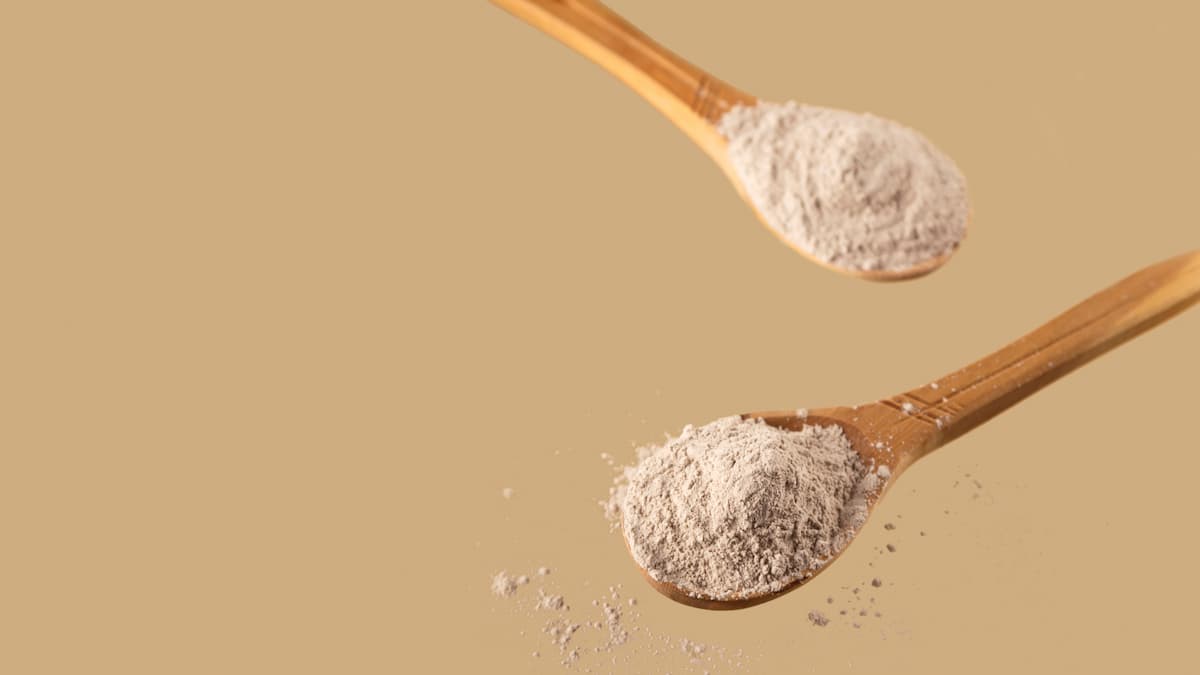
Everything you want to know about COLLinstant collagen.

Collibre collagen is an interesting supplement in shot form.
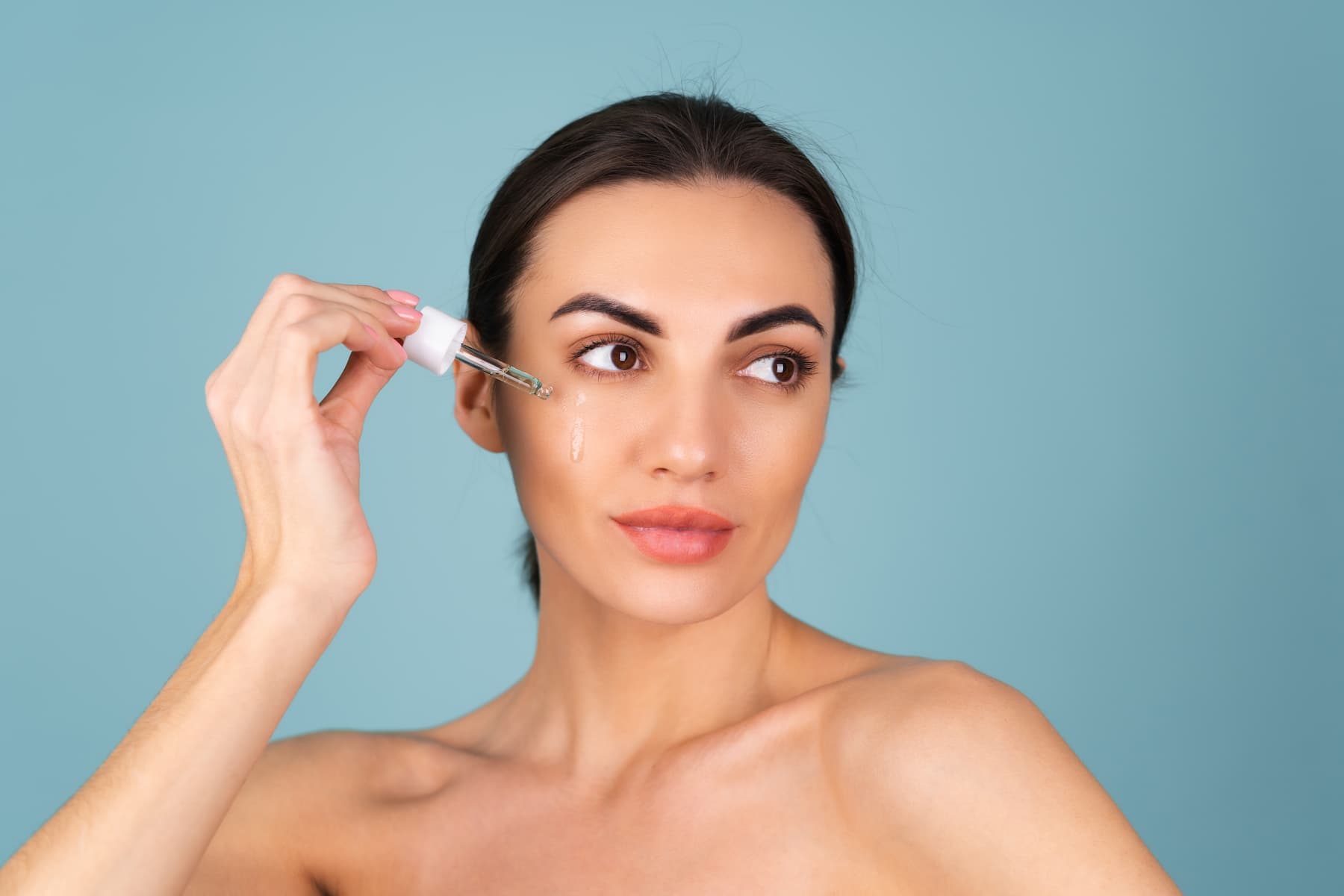
Solgar collagen with hyaluronic acid is a dietary supplement that supports skin and joint health.
